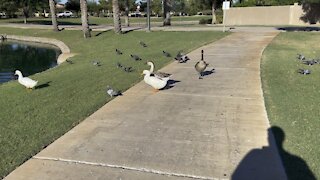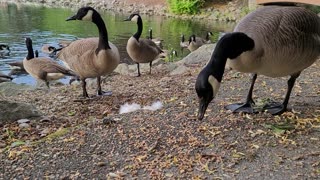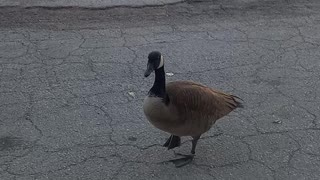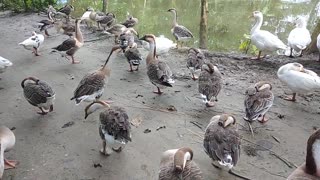Goose lays an egg
The three living genera of true geese are: Anser, grey geese, including the greylag goose, and domestic geese; Chen, white geese (often included in Anser); and Branta, black geese, such as the Canada goose.
Two genera of geese are only tentatively placed in the Anserinae; they may belong to the shelducks or form a subfamily on their own: Cereopsis, the Cape Barren goose, and Cnemiornis, the prehistoric New Zealand goose. Either these or, more probably, the goose-like Coscoroba swan is the closest living relative of the true geese.
Fossils of true geese are hard to assign to genus; all that can be said is that their fossil record, particularly in North America, is dense and comprehensively documents many different species of true geese that have been around since about 10 million years ago in the Miocene. The aptly named Anser atavus (meaning "progenitor goose") from some 12 million years ago had even more plesiomorphies in common with swans. In addition, some goose-like birds are known from subfossil remains found on the Hawaiian Islands.
Geese are monogamous, living in permanent pairs throughout the year; however, unlike most other permanently monogamous animals, they are territorial only during the short nesting season. Paired geese are more dominant and feed more, two factors that result in more young.
When Aphrodite first came ashore she was welcomed by the Charites (Roman "Graces"), whose chariot was drawn by geese.
There are Mother Goose tales, such as a farmwife might have told; there is the proverbial goose that laid the golden eggs, warning about the perils of greed.
The geese in the temple of Juno on the Capitoline Hill were said by Livy to have saved Rome from the Gauls around 390 BC when they were disturbed in a night attack.[6] The story may be an attempt to explain the origin of the sacred flock of geese at Rome.
Because domestic geese descended from the Greylag goose are effectively the same species as their wild ancestor (being a subspecies formed through domestication), escaped individuals readily breed with wild populations, resulting in the offspring sometimes resembling either one of their parents, or bearing mixed plumage with patterns of grey and white feathers and orange beaks.Each goose egg that I purchased was sold individually rather than in a carton. They cost $1.99 each and were hard as a rock when you tried to crack them, leading me to think they might have been wild eggs from the Canadian geese living in the area.
-
 1:15
1:15
KIVI
2 years agoGoose Fire
5 -
 10:06
10:06
threestrikesurout
2 years agoNonograms - Goose
12 -
 0:17
0:17
mgallin27
2 years agoGoose standoff
14 -
 2:06
2:06
Maxing And Relaxing
2 years agoWatch A Goose Goose another Goose
27 -
 0:22
0:22
Jack Hatter
2 years agoBreakfast with a goose
14 -
 1:38
1:38
Nutur725
2 years agoGoose bird
14 -
 0:24
0:24
Silvat1978
2 years agoChinese goose restaurant.
16 -
 1:35:58
1:35:58
2 MIKES LIVE
7 hours ago#71 2ML The Memorial Day Show!
38.1K6 -
 1:28:17
1:28:17
RealitySurvival
6 hours agoPREPPER SITREP - Weekly News Wrap Up Of Prepper Centric News Stories
30.8K2 -
 58:49
58:49
Kimberly Guilfoyle
14 hours agoRevolver News Exclusives: Major J6 Developments w/ Darren Beattie | Ep. 129
59K72